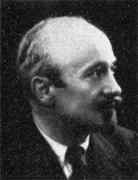Person: Esclangon, Ernest Benjamin

Ernest Esclangon was a French astronomer and mathematician who worked on almost-periodic functions.
Mathematical Profile (Excerpt):
- Ernest was born in Misson which consisted of scattered hamlets and buildings in addition to three main villages.
- Ernest was educated at this school in Manosque before going to the Lycée in Nice to prepare for entry into the Grand Écoles of Paris.
- Although Esclangon accepted a post at the university observatory, he continued to work on mathematical topics for his doctorate and also taught mathematics at the Faculty of Sciences at Bordeaux University.
- As was standard procedure at the time, candidates for a doctorate had to submit a second thesis and Esclangon's second thesis was Théorie des tourbillons Ⓣ(Theory of vortices); it was not published.
- Esclangon elaborated a theory for these functions, studied their differentiation and integration, and examined the differential equations which allow them as coefficients.
- In 1902 there appeared in Volume 135 of Comptes rendus of the Paris Academy of Sciences a note written by Esclangon (communicated by Paul Painlevé) entitled 'Sur une extension de la notion de périodicité' (On a generalization of the concept of periodicity).
- Bohl read this note and concluded that Esclangon's concept of "quasi-periodic function" agreed with the "periodic function in generalized sense" that he had defined in his master's dissertation.
- In 1903 Bohl found a second note by Esclangon in the "Comptes rendus", in which he acknowledged Bohl's priority in the discovery of the new functional class.
- In the same note Esclangon announced that he had reached independently of Bohl many results, discussed the differences between the two works, and presented several new results.
- Bohl was very pleased with this response; in the subsequent correspondence between him and Esclangon he shared his ideas on various new research results and commented very favourably on Esclangon's scientific projects.
- In 1905 Esclangon was promoted to Deputy Astronomer at the Bordeaux Observatory.
- It was in September that Esclangon presented his ideas to the Service Géographique de l'Armée on pinpointing the position of an enemy gun from the sound of it firing.
- Esclangon was conscripted into the 55th Infantry Regiment and was assigned to the commission for naval artillery, part of the ballistics and sound ranging service.
- There were many problems which had to be solved before Esclangon's idea of using triangulation to pinpoint gun positions could work in practice.
- It is worth noting that General Erich Ludendorff, German Quartermaster General from 1916 to 1918, states in his memoirs Ludendorff's Own Story (1920) that Esclangon's device was one of the main reasons that the Allies defeated the Germans.
- Although Esclangon had staff recruitment difficulties, he did have the help of André Danjon (1890-1967) in his reorganisation of the Strasbourg Observatory.
- He would be appointed as its director after Esclangon left Strasbourg in 1929.
- The range of topics on which Esclangon worked during his career is quite remarkable.
- By studying the reflection of light from a mirror, Esclangon found strong evidence for an "optical dissymmetry of space" which can be explained by an ether drift.
- Esclangon broadcasts the time through a series of photoelectric cells, which activated 'pistes sonores' located on a rotating cylinder.
- On that day Esclangon considered operating the speaking clock from Bordeaux to continue to give an accurate time to the radio if Paris fell to the advancing Germans.
- Esclangon retired as Director of the Paris Observatory and as Professor of Astronomy at the Sorbonne in 1946.
- Esclangon was honoured with election to the Académie des Sciences in 1929 and the Bureau des Longitudes in 1932.
- They much appreciated Esclangon's kindness, simplicity, and the accuracy of his weather forecasts.
- The binary asteroid 1509 Esclangona is named after him as is the lunar crater Esclangon.
- On 22 June 1965 the Paris street previously named Ornano, was named for Esclangon.
Born 17 March 1876, Misson (N of Sisteron), Alpes-de-Haute-Provence, France. Died 28 January 1954, Eyrenville, France.
View full biography at MacTutor
Tags relevant for this person:
Astronomy
Thank you to the contributors under CC BY-SA 4.0! 

- Github:
-

- non-Github:
- @J-J-O'Connor
- @E-F-Robertson
References
Adapted from other CC BY-SA 4.0 Sources:
- O’Connor, John J; Robertson, Edmund F: MacTutor History of Mathematics Archive
